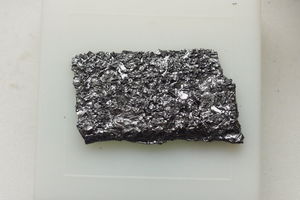Difference between revisions of "Silicon carbide"
m (→Safety) |
(→Preparation) |
||
| Line 121: | Line 121: | ||
==Preparation== | ==Preparation== | ||
| − | + | Because of the rarity of natural moissanite, most silicon carbide is synthetic. It is used as an abrasive, and more recently as a semiconductor and diamond simulant of gem quality. The simplest manufacturing process is to combine silica sand and carbon in an Acheson graphite electric resistance furnace at a high temperature, between 1,600 °C (2,910 °F) and 2,500 °C (4,530 °F). Fine SiO2 particles in plant material (e.g. rice husks) can be converted to SiC by heating in the excess carbon from the organic material.[15] The silica fume, which is a byproduct of producing silicon metal and ferrosilicon alloys, also can be converted to SiC by heating with graphite at 1,500 °C (2,730 °F). | |
==Projects== | ==Projects== | ||
Revision as of 18:59, 24 January 2016
 Silicon carbide sample.
| |
| Names | |
|---|---|
| IUPAC name
Silicon carbide
| |
| Other names
Carborundum
Moissanite | |
| Identifiers | |
| Jmol-3D images | Image |
| |
| Properties | |
| SiC | |
| Molar mass | 40.10 g/mol |
| Appearance | Black lustrous solid |
| Density | 3.21 g/cm3 |
| Melting point | 2,730 [convert: invalid number] |
| Boiling point | [convert: invalid number] |
| Insoluble | |
| Hazards | |
| Safety data sheet | ScienceLab |
| Except where otherwise noted, data are given for materials in their standard state (at 25 °C [77 °F], 100 kPa). | |
| Infobox references | |
Silicon carbide, also known as carborundum is a compound of silicon and carbon with chemical formula SiC, mainly used as an abrasive. Silicon carbide occurs naturally as the rare mineral moissanite.
Contents
Properties
Chemical
Physical
Availability
Delete this section if not applicable
Preparation
Because of the rarity of natural moissanite, most silicon carbide is synthetic. It is used as an abrasive, and more recently as a semiconductor and diamond simulant of gem quality. The simplest manufacturing process is to combine silica sand and carbon in an Acheson graphite electric resistance furnace at a high temperature, between 1,600 °C (2,910 °F) and 2,500 °C (4,530 °F). Fine SiO2 particles in plant material (e.g. rice husks) can be converted to SiC by heating in the excess carbon from the organic material.[15] The silica fume, which is a byproduct of producing silicon metal and ferrosilicon alloys, also can be converted to SiC by heating with graphite at 1,500 °C (2,730 °F).
Projects
- Crucible
Handling
Safety
Silicon carbide is non-flammable and non-explosive.
Effects of Exposure: To the best of our knowledge the chemical, physical and toxicological properties of silicon carbide have not been thoroughly investigated and reported. Silicon carbide is a nuisance dust capable of producing nonprogressive pulmonary fibrosis. Silicon carbide implants have caused tumors in laboratory animals.
Acute Effects: Inhalation: May cause irritation. Ingestion: No acute health effects recorded. Skin: May cause abrasive irritation. Eye: May cause abrasive irritation.
Chronic Effects: Inhalation: May cause pneumoconiosis. No other chronic health effects recorded.
Target Organs: No target organs recorded. Medical Conditions Generally Aggravated by
Exposure: Pre-existing respiratory disorders.
Carcinogenicity: NTP: No IARC: No OSHA: No
Storage
Disposal
References
Relevant Sciencemadness threads
- Chemical pages without CAS Registry Number
- Articles without EBI source
- Chemical pages without ChemSpiderID
- Chemical pages without DrugBank identifier
- Articles without KEGG source
- Articles without InChI source
- Articles without UNII source
- Convert invalid options
- Articles containing unverified chemical infoboxes
- Chemical compounds
- Inorganic compounds
- Silicon compounds
- Carbides
- Insoluble compounds